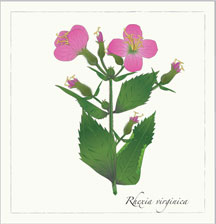Description: There are approximately twelve North American species of Rhexia, six of which are found along the eastern seaboard. Rhexia virginica is the most ubiquitous of the group, ranging from Nova Scotia at its northernmost extent, to Florida and Texas to the south. Commonly known as Meadow-beauty, Handsome Harry, and Deer Grass, Rhexia virginica is found in moist, sunny locations where the soil is acidic. Typical habitats include bogs, wet meadows, and acidic pond shores.
Meadow-beauty is a perennial herb with a four-petaled, magenta blossom measuring about 1 to 1.5 inches  across. Eight yellow stamens extend like a beard beyond the petioles, with the pistil even longer than the stamens to aid in cross-fertilization. Plants are cross-fertilized by nectar feeding insects such as honeybees and the common yellow sulfur butterfly (Colias philodice). Flowers form at the terminal ends of branches in late summer, usually blooming from late July to August and continuing through September. The fruit is a four-sided pitcher-shaped capsule. The capsule is woody and can be shaken upside down to empty the ripened seeds through a small opening at the tip. The stem is squared and slightly winged at the edges. Toward the base, and particularly underwater, the stem becomes fleshy and fibrous as an adaptation for absorbing oxygen from the water. The leaves are opposite along the stem, with three prominent veins and small teeth along the margins. Both stem and leaves (upper and lower surfaces) are smooth, though dotted with glandular hairs, which give the plant a bristly appearance.
across. Eight yellow stamens extend like a beard beyond the petioles, with the pistil even longer than the stamens to aid in cross-fertilization. Plants are cross-fertilized by nectar feeding insects such as honeybees and the common yellow sulfur butterfly (Colias philodice). Flowers form at the terminal ends of branches in late summer, usually blooming from late July to August and continuing through September. The fruit is a four-sided pitcher-shaped capsule. The capsule is woody and can be shaken upside down to empty the ripened seeds through a small opening at the tip. The stem is squared and slightly winged at the edges. Toward the base, and particularly underwater, the stem becomes fleshy and fibrous as an adaptation for absorbing oxygen from the water. The leaves are opposite along the stem, with three prominent veins and small teeth along the margins. Both stem and leaves (upper and lower surfaces) are smooth, though dotted with glandular hairs, which give the plant a bristly appearance.
Cultivation: Natural growing conditions for Rhexia virginica are acidic and low in available nutrients. The soils are composed primarily of sand or undecomposed organic material, with a moisture regime ranging from standing water to moist pond shores. They are found in full sun and partial shade, as you would find along the margin of an open habitat. Rhexia virginica is suitable for growing in moist garden settings and is certainly suitable for bog or wet meadow gardening. The plants are typically low growing, achieving about 12 inches in northernregions (3 feet at the southern extent of its range). Meadow-beauty survives the winter by forming tubers along the roots that are covered in adventitious buds. Plants appear to migrate somewhat from year to year as the crowns develop on tubers formed in the previous growing season. Plants can be transplanted and can also be started from seed and will bloom in their second season. Both plants and seeds were listed in the New England Wild Flower Society's 2001 nursery and seed catalogues.
Propagation: Seed can be collected from ripe capsules in late summer. When ripe, the capsule opens slightly at the top, and the seeds can be shaken out. Seeds require 90 days of cold (less than 40 degrees F.), moist, stratification to germinate. Seeds can be sown outdoors in a cold frame in the fall, or in a pot covered in a plastic bag and refrigerated for 90 days. Seed-starting soil should be light and can be mixed with equal parts of sand, soil, and peat moss. The germination of Rhexia virginica seeds requires warmth (70 degrees F.) and light. The seeds should not be covered after sowing. Pots or flats should be watered from the bottom up as necessary to keep the soil moist. The tiny seedlings will require frequent fertilization with a dilute fertilizer to get them started. Generally, seedlings should be large enough to transplant either into pots for over-wintering or to a moist to wet, acidic, garden location by mid-summer. Plants will bloom the following season.
Flowering - June - October.